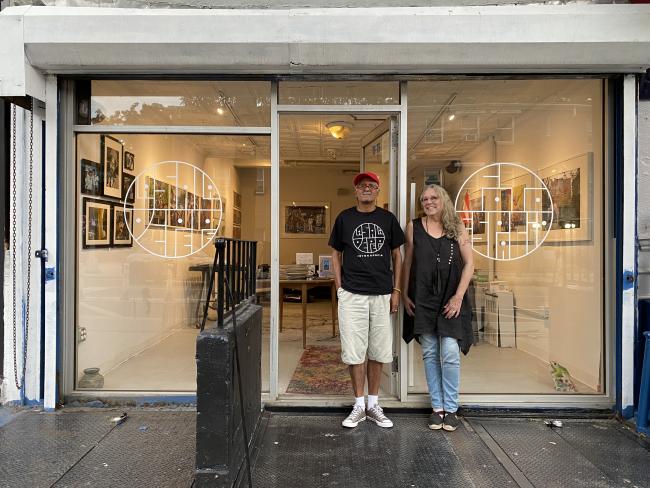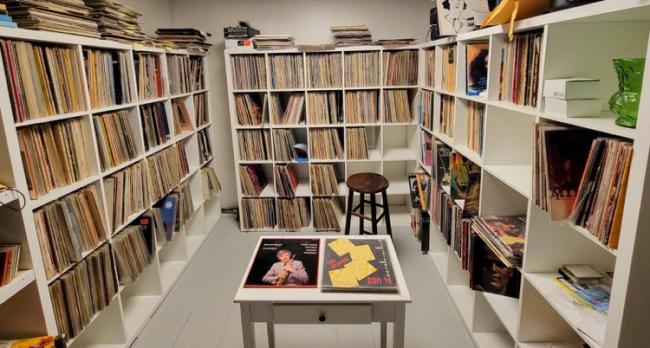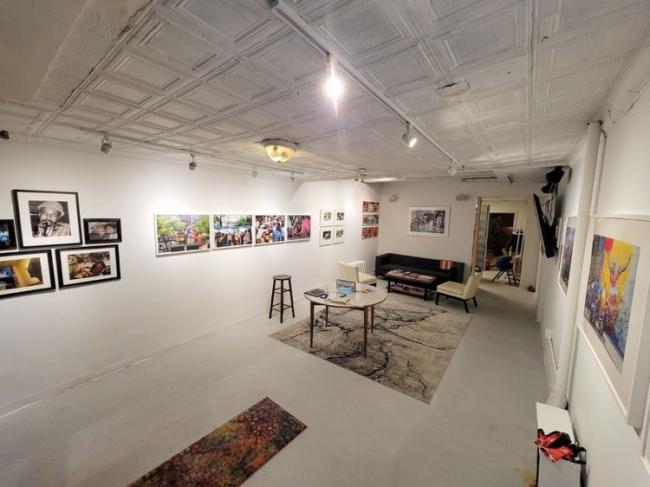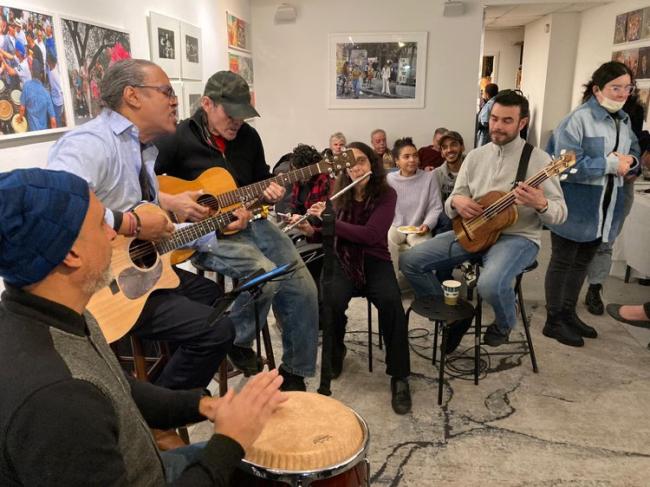
The storefront is simple with uncovered windows, inviting passersby to view the space from the street. Walking into the open layout, visitors are immediately introduced to the intention of the space with a photograph placed in a white frame on the wall directly facing the entrance. It’s an image by Marlis Momber, a German photographer who documented the Loisaida community in the 1970s and 1980s. “Loisaida” is Spanglish for the Lower East Side, a term that celebrates the Puerto Rican and Latino heritage of the area. The image is from the 1970s. There is graffiti in the background and a Puerto Rican woman stands on the street with her hand on her hip and two kids behind her, all looking at the camera. Off to the right is a Hector Lavoe-looking man in all white with a collared shirt, rolled up sleeves, one hand in his pocket, sleek brown hair, and all the swag in the world.
La Sala de Pepe, a former photo frame shop owned by one of Keith Haring’s collaborators, Angel Ortiz, is now a foto espacio and social club on Avenue C in the heart of Alphabet City. It is run by Puerto Rican local Jose “Pepe” Flores and Lower East Side native and anthropologist Lyn Pentecost. In Pepe and Lyn’s words, “its immediate purpose is to stem the tide of cultural amnesia in the neighborhood.”
They describe it as a “new kind of social club and art space where the past literally meets the future.” "We want to have a place for people to meet and talk and to preserve the spirit of Loisaida," Pepe says. "A way to break up historical forgetfulness. A social space in the neighborhood for all ages to talk and listen to music.” Alphabet City has a rich history of longstanding Latino institutions such as the Nuyorican Poets Cafe and The Loisaida Center, a multidisciplinary community development organization, but the continuous effects of gentrification threaten ethnic erasure, not only for the spaces people frequent but the people themselves.
Combating Gentrification
In late 2021, Casa Adela, a beloved Puerto Rican restaurant in business for almost five decades and located across the street from La Sala de Pepe, received a striking 400 percent rent hike from its landlord. This was around the same time Pepe and Lyn were opening their new space. How can a Latino social club open in gentrified Alphabet City where rents are as high as $7,000 a month?
The idea for La Sala de Pepe came about from Pepe’s 10,000-record music collection that has been housed in his apartment for decades, located upstairs from the now social club. Over the years, academics, students, and community members have reached out to him to visit the archive. This encouraged Pepe to reflect on how to make the collection more accessible. When the commercial space below his apartment became available, he called Lyn, a friend of 40 years, and La Sala de Pepe was born.

Pepe’s building is actually a Housing Development Fund Corporation, or HDFC co-op building. HDFCs are an affordable homeownership option in New York City that was created in 1966 when the city seized thousands of buildings that were in a state of abandon. Select buildings in impoverished neighborhoods like the Bronx and Alphabet City were sold to tenants with the goal of stabilizing rent for long-term, low-income residents.
Although the residential units in these buildings are regulated, commercial space in New York City is not. However, in a universal alignment of sorts, Pepe’s building manager, who is a housing activist from the neighborhood, wanted to see the space put to good use and offered a decent monthly rent to make La Sala de Pepe possible.
The commercial space Casa Adela occupies is also part of a HDFC building, but the flip side to HDFCs is that many are ridden with maintenance and cash flow issues. For several reasons—including the lack of rent increases over time and the need for maintenance—the board attempted to raise the rent from $1,350 to $6,750. After an uproar from the local community and back and forth negotiations, the board and Casa Adela came to a mutual agreement. Unfortunately, other Latino institutions in New York City, particularly social clubs, have not been as successful in fighting displacement over the decades.
Latin Social Clubs: A Rich Cultural History
Latino social clubs have a long history as cultural hubs and community development centers that have helped generations of immigrants integrate into New York City life. La Nacional Spanish Benevolent Society is considered the oldest immigrant club in the city and the start of a thriving culture of social institutions for Latinos in New York.
La Nacional, which is currently located on West 14th Street but originally opened in the Lower East Side in 1868, was founded by a small group of Spaniards who wanted to create a social space for newcomers to the city. Given Spain’s immediate connection to Latin America and the Caribbean, La Nacional also became a safe haven for Latino immigrants, and since its inception the club nurtured solidarity between Spanish and Latin American residents.
The decades between the 1950s and the 1970s, known as the golden age of mass Latino immigration to New York City, fostered a profusion of Latin social clubs across the city. A wave of artists, poets, musicians, intellectuals, workers, and families filled the streets of Spanish Harlem, the Lower East Side, and parts of the Bronx and Brooklyn. Although rich in diversity, the city was not entirely keen on foreigners, and Latino immigrants experienced rampant institutional racism, discrimination, and violence. Similar to La Nacional, self-preservation was integral to the formation of social clubs.
At a time when the city abandoned, defunded, or refused to invest in these communities, Latinos invested in their own community-building and development. Many small and large-scale Latino social clubs opened in response to situations of social and economic precarity, such as El Caribe CC and Toñita’s (1973) in Brooklyn and El Morel Campos Social Club and Club Social Salinas in Manhattan. Spanish Harlem gave birth to the Devils (1940s), the Old San Juan Social Club, and Asociación Civíca Lareña (1940-1990s), and El Club Deportivo Dominicano (1966) was founded in Washington Heights. In the Bronx, there was Tu Casa Social Club, Happy Land (1958-1990), El Club Cubano Inter-Americano (1945-2006), and El Habana Social Club.

Social clubs weren’t only spaces to socialize, play dominoes, sponsor dance competitions, and teach salsa. They also helped the community raise money for members, fight on political fronts, and access housing, jobs, and food. For example, Toñita’s, known as the last Caribbean social club in Williamsburg, still provides hot food every night free of charge for the community. These clubs offered a way for Latinos to shield themselves from xenophobia, preserve their dignity, and be with their community to celebrate their culture and traditions.
Yet while the Latino community built reinforcements, a larger monster was taking shape—the commodification of housing. The golden age of Latino migration was circumscribed by a period of severe economic crisis that swept across the country between the early 1970s and early 1980s. Inflation was at an all-time high, the Federal Reserve increased interest rates to nearly 20 percent, the stock market lost almost half its value in less than two years, economic growth slowed, and unemployment exceeded 10 percent. Commodities that were once profitable in the stock market plummeted in value, forcing vulture capitalists to find new avenues of investment. One of those avenues was housing.
In the late 1970s, housing development surged around the country, with local governments conceding to and working in partnership with real estate. New York City was no exception. A period of aggressive gentrification was underway, with the speculation of real estate investors creeping into historically underfunded neighborhoods like the Lower East Side, which, tied with public policy, resulted in a spike in land value. In time, rents increased for tenants and displaced those who weren’t rent stabilized, including the commercial spaces occupied by Latino social clubs.
Most of the once-thriving social clubs do not exist anymore today, taking with them rich cultural histories and memories, and important mechanisms of community support. La Sala de Pepe is now part of this legacy of social clubs and art venues, creating a critical space where Latinidad can be celebrated, where people of color can convene in an area that is already largely inaccessible after successive waves of gentrification, while also providing a safe haven for those who remain.
La Sala de Pepe

The new social club opened in December 2021 and has since not only welcomed community members to sit and chat and college students and academics to explore the record archive. The venue has also curated exhibitions such as Charlie Rosario: Dedicated to the Drum, about the Brooklyn-born Puerto Rican artist and musician; screened movies including Last One Standing, the story of Adela, the founder of Casa Adela; and hosted cultural events such as Women in Bomba: Bomba and Beyond, adding an element of popular education.
La Sala accompanies a number of surviving and newer Latino cultural institutions in Alphabet City—a vibrant collection of cultural centers, arts non-profits, community gardens, and small businesses such as Nuyorican Poets Cafe, The Loisaida Center, Casa Adela, Piragua Art Space, La Plaza Cultural Garden, and others who, like Pepe and Lyn, are all working to combat the tide of cultural amnesia in the community.
“Despite the invasion of massive amounts of real estate capital, Loisaida remains a vibrant community,” says Lyn. “The arts are a form of empowerment and a source of great resilience that has been handed down generationally.”
Damaly Gonzalez is a Brooklynite, Williamsburg-native of Puerto Rican descent that goes by she/her/hers. She is an identity and culture writer who writes opinion, analytical, and idea pieces through stories about everyday life experiences in order to stimulate deep conversations and give rise to conscious minds. She has been published in The Latinx Project at NYU, NBC Latino, and others. Damaly holds a master’s degree in History and Urban Sociology from The Graduate Center, CUNY. Follow her on Instagram @damalyscorner.

